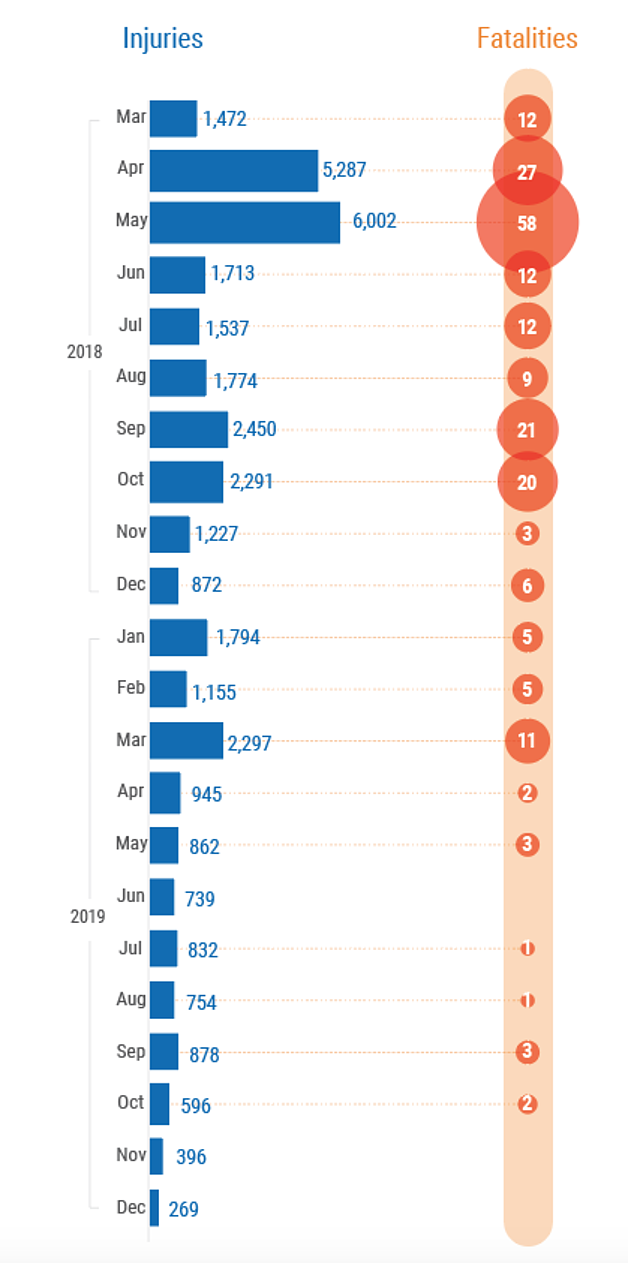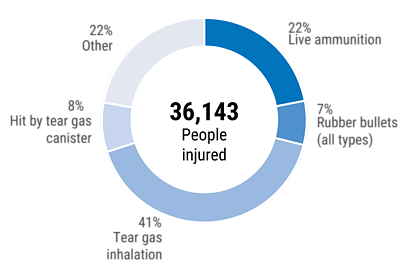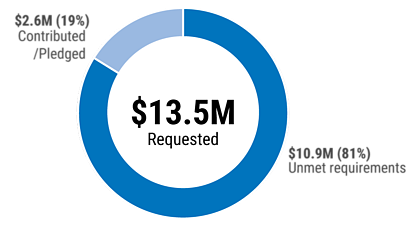Posted on 6 April 2020
Mohammed, 35 and father of three, from Beit Hanoun, was shot with a live bullet in the leg during the first “Great March of Return” (GMR) demonstration on 30 March 2018. “I went through 25 surgeries, but I’m still in pain,” he told OCHA. As a result of his disability, Mohammed lost his job as a construction worker and the economic situation of his family began to deteriorate. “My wife couldn’t bear with my situation and with the poverty, so we got divorced. My life is nothing but a misery.”
The GMR demonstrations in Gaza were suspended at the end of 2019. However, like Mohammed, thousands of wounded or traumatized people continue to suffer the consequences. To support their rehabilitation and mitigate the impact on them and their families, humanitarian agencies have appealed for US$13.5 million for a range of interventions during 2020;[1] so far only 19 per cent of this amount was secured.
Lack of funding is not the only impediment to respond to the health needs of the affected people. Many patients with complex injuries, who were referred to specialized treatment in the West Bank, including East Jerusalem (and occasionally in Israel), have not been granted an exit permit by the Israeli authorities. Given the severe limitations of Gaza’s health system, unless reversed, this policy will continue to undermine the patients’ prospects of recovery.
Crowd-control methods used by Israeli forces during the GMR have raised serious concerns about excessive use of force, compounded by a lack of effective investigations and accountability. Also of concern are indications that Hamas authorities have not done enough to protect children attending the demonstrations and prevent their exposure to the risk of violence or instrumentalization for political action. As the GMR demonstrations, or others, will resume in the future,[2] it is critical that both authorities modify these policies and practices to avoid further casualties and unnecessary suffering.
 Palestinian injured during a demonstration protesting the naval blockade on the beach near the fence ,
Palestinian injured during a demonstration protesting the naval blockade on the beach near the fence ,
northwest of Beit Lahiya. September 2018. Photo by Ashraf Amra
The casualty toll
Since 30 March 2018, Palestinians have been holding the GMR demonstrations, calling for the Palestinian right of return and the ending of the Israeli blockade. Thousands participated in the gatherings taking place every Friday and on special days at five locations along the perimeter fence; smaller protests were held during the week at the beach and at various locations near the fence during the night.
While the vast majority of protestors have acted in a peaceful manner, during most protests dozens have approached the fence attempting to damage it, burning tires, throwing stones and Molotov cocktails towards Israeli forces and flying incendiary kites and balloons into Israeli territory; the latter resulted in extensive damage to agricultural land and nature reserves inside Israel and risked the lives of Israeli civilians. Some incidents of shooting and throwing of explosive devices have also been reported.
Israeli forces responded by shooting tear gas canisters, some of them dropped from drones, rubber bullets and live ammunition, mostly by snipers. As a result, 214 Palestinians, including 46 children, were killed, and over 36,100, including nearly 8,800 children have been injured. One in five of those injured (over 8,000) were hit by live ammunition.[3] During the same period, one Israeli soldier was killed and seven others were injured during the demonstrations.
Palestinian casualties in the GMR 2018-2019
Palestinians injured during the GMR demonstrations by weapon
Over 1,200 people require long-term and expensive rehabilitation
Over 7,000 of the live ammunition injuries (some 88 per cent) were limb injuries, followed by injuries to the abdomen and pelvis. Hundred-fifty-six (156) of the limb injuries have resulted in amputations (126 lower limb and 30 upper limb). Out of these, at least 94 cases involved secondary amputations, due to subsequent bone infections.
The latter usually occur when a limb injury is compounded by more extensive damage to the skin, tissue, nerves and blood vessels. It is estimated that between 25 and 40 per cent of patients with such complications go on to develop some form of bone infection over a 12-month period following the injury. In other cases, the injury leads to an open fracture that is either non-healing or leaves bone gaps, which also require specialized orthopedic plastic-reconstructive surgery. The World Health Organization (WHO) estimates that over 1,200 of those who sustained limb injuries have begun, or are waiting for, specialized limb reconstruction treatment.
 A member of the Palestine Red Crescent Society attends the Great March of Return demonstrations
A member of the Palestine Red Crescent Society attends the Great March of Return demonstrations
on 27 April 2018 to provide health support to those injured.
Limb reconstruction treatment and rehabilitation usually extends from six months to three years, depending on the severity of the case, and involves two to eight surgeries and 12 to 30 physiotherapy sessions. The cost of each individual treatment may reach as much as $ 40,000.
The lives of people with such complex injuries are dramatically impacted. Most have lost their jobs due to their disabilities and posed an additional burden on already vulnerable households. The majority would not be able to recover without the support of public services and the humanitarian community.
“Following my divorce, I couldn’t feed my children, so I had to send one of them to live with my mother, one with my brother and one with my sister,” Mohammed said. “For a year and a half I couldn’t move my leg. Thanks to physiotherapy sessions I can walk again but I can’t work. I just sit at home and do nothing. Since the start of the corona virus [COVID-19] the medical teams stopped visiting me and the situation of my leg worsened”.
Gaza’s health system has been undermined by the over-decade long Israeli blockade, the internal Palestinian divide, a chronic power deficit and shortages in specialized staff, drugs and equipment. Consequently, people with complex injuries are frequently referred to more advanced facilities in the West Bank, including East Jerusalem, and sometimes in Israel. To reach these facilities, patients require an exit permits from the Israeli authorities, which are not always granted or granted in time.
Out of the 604 permit applications submitted for people injured during the GMR, only 17 per cent were approved, 28 per cent were rejected and 55 per cent did not receive an answer in time for the medical appointment.[4] This is below the rate of approval of all permit applications by patients in 2018 and 2019, which stood at 61 and 65 per cent respectively. Given the severe limitations of Gaza’s health system, unless reversed, this policy will continue to undermine the patients’ prospects of recovery.
Some 22,500 children in need of psychosocial support
The GMR demonstrations have also had widespread mental health and psychosocial consequences. Impacted people include those injured during the protests, particularly those who sustained physical disability, their caregivers, those who were directly exposed to extreme violence, especially children, and people who lost a family member.
In 2020, an estimated 10,400 people will suffer severe mental health problems in connection to the GMR demonstrations, and nearly 42,000 people will have mild to moderate problems.[5] These figures include over 22,500 children.[6] Unless they receive specialized support, including individual case management services, the situation of many may deteriorate rapidly. Negative ramifications include the loss of income, school dropout among children, and domestic violence in affected households.
 Children participating in an unstructured psychological support session, Beit Lahyia, the Gaza Strip.
Children participating in an unstructured psychological support session, Beit Lahyia, the Gaza Strip.
Photo by Terre des Hommes Lausanne
Mustafa, 14-years-old, was hit by a tear gas canister in the neck during a demonstration that took place on 25 August 2018 and was hospitalized for a week. After he recovered physically, he received support from an international NGO (Terre Des Hommes), as part of which he participated in group counselling and role-playing sessions, among other activities. “By talking about my experience, a lot of the stress was released. Although I get tired quickly and can’t play soccer as I used to, I’m better”, he said. Mustafa is also taking private lessons to improve his grades. “I no longer listen to my friends who encouraged me to go to the demonstrations. All that I focus on now is my study and nothing else.”
Gender-based violence exacerbated
Preliminary findings of a survey carried out by the Palestinian Central Bureau of Statistics (PCBS) in the second quarter of 2019 revealed that 38 per cent of women in Gaza reported some form of psychological, physical, sexual, social or economic violence by their husbands, at least once during the preceding 12 months.[7]
While domestic violence is a longstanding concern in the oPt, the Gender-Based Violence (GBV) Sub-Cluster estimates that the GMR has exacerbated it.[8] Evidence gathered by partners to the working group indicate that mothers have been often blamed by their husbands for the injury or death of their children during a demonstration, and experienced increased related violence. Additionally, widows are at higher risk of immediate psychological and economic violence by family members, as some are expected to re-marry and the family of the late husband often take control over their finances. Further, girls who lost a father, or have a father with a disability, are at increased risk of forced child marriage due to the decreased level of household income, as fathers/husbands are usually the breadwinner of the family.
Yasmin, is a 22-year-old mother living in the north area. “I used to live a happy life, but all changed after my husband was killed in May 2018, during a GMR demonstration. With my two sons I returned to my family’s house and stayed there for a year and a half. As a widow, I was under tighter control by my family.” As is customary, Yasmin was requested to marry her brother-in-law. At first, she refused, but following pressure she accepted. “I didn’t want to go back to my husband’s family home, as they treated me badly. Soon after we married, my new husband began beating me. I never imagined that someone would do that to me. After the killing of my first husband, I started to attend psychosocial support sessions. They helped me feel better, less stressed. However, after I married again, I could no longer attend as my husband’s family opposed that. Now it’s all back again.”
Proposed interventions and funding requirements
The HRP 2020 for the oPt, includes eighteen (18) projects addressing the specific health and protection needs in the Gaza Strip of people that were affected by the GMR, for which approximately $13,5 million are required.[9]
The projects entail increasing access to basic and specialized services for persons with injuries and disabilities, including medical rehabilitation and mental health and psychosocial support (MHPSS) services. They also aim at improving access to essential, safe and high quality GBV multi-sectoral services as well as awareness raising, economic empowerment and legal aid. Moreover, the projects involve awareness raising activities, such as advocacy to protect the right to health of the most vulnerable. As of March 2020, $2,6 million has been contributed or pledged in support of these projects.
GMR related interventions in HRP 2020
Concerns over excessive use of force and lack of accountability
Under international human rights law, the use of lethal force in law enforcement activities is allowed only as a last resort and only in response to imminent threat to life, or serious injury. Numerous investigations found evidence that demonstrators killed or seriously injured during the GMR demonstrations have posed no such threat to Israeli forces.
An independent commission of inquiry appointed by the Human Rights Council (HRC), investigated all demonstration-related fatalities and more than 700 injuries since the start of the GMR through the end of 2018. With the exception of two cases, the commission found reasonable grounds to believe that the use of live ammunition by Israeli forces was unlawful.[10] The Government of Israel rejected the findings of the HRC commission as biased, stating that they failed to consider the threat posed by violent acts from Gaza.
Israel has the obligation to investigate allegations of violations committed by its security forces against Palestinians and hold potential perpetrators accountable. Accountability is essential to ensure justice for the victims and to prevent future violations.
The Israeli military has set up a fact-finding mechanism to assess allegations in the context of the GMR. According to the Israeli authorities, as of end July 2019 this mechanism reviewed 226 cases and referred ten of them for a criminal investigation by the Military Police.[11]
So far, only one soldier was prosecuted for the killing of a 14-year-old boy during a demonstration: in October 2019 he was convicted of “unauthorized shooting” and sentenced to one month in prison and a suspended prison sentence of two-months. According to the High Commissioner for Human Rights, “the case appears to highlight structural limitations inherent to the Israeli military justice system in focusing on the responsibility of soldiers in complying with orders and standard operating procedures, without addressing the legality of those same rules of engagement and the connected responsibility of military commanders”.[12]
There are no indications that the Hamas authorities have taken any measure to ensure accountability for the failure to provide adequate protection and the possible instrumentalization of children during the GMR.
[1] This request is part of the Humanitarian Response Plan for the oPt officially launched on 11 December 2019
[2] A large demonstration to commemorate the second anniversary of the GMR, which was planned to take place on 30 March 2020, was postponed due to the COVID-19 crisis.
[3] These figures include all casualties during GMR-related incidents, including the night events near the fence. An additional Palestinian was killed after being mistakenly hit by a stone thrown by Palestinians.
[4] HEALTH CLUSTER BULLETIN November-December 2019.
[5] HUMANITARIAN NEEDS OVERVIEW 2020. The overall caseload of people in need of MHPSS in Gaza is 419,684. This figure includes 148,955 adults (55% women and 45% men) and 270,689 children (50% girls and 50% boys).
[6] Child Protection AOR (Area of Responsibility) estimates at least 22,578 children impacted by the ‘Great March of Return’ (GMR) will be in need of moderate and severe MHPSS support through specialized individual case management services to address high levels of psychosocial distress. This adds to the already significant mental health burden of 248,111 children in Gaza in need of structured psychosocial support (PSS) services and child protection interventions.
[7] The survey targeted 12,942 households in the West Bank and Gaza Strip. The preliminary findings were released on November 2019. The survey includes findings about other forms of violence in Palestinian society, including by Palestinians and by Israeli forces and settlers, in a range of contexts.
[8] Impact of the ‘Great March of Return’ on Gender-based Violence- Situation report 8 June 2019, GBV Sub-Cluster Palestine
[9] Although the main target is people affected by GMR, there are other people targeted as part of the projects. Two of these projects similarly target people in the West bank.
[10] Report of the independent international commission of inquiry on the protests in the Occupied Palestinian Territory.
[11] Report by United Nations High Commissioner for Human Rights, para. 24.
[12] Ibid., para. 25.
Document Sources: Office for the Coordination of Humanitarian Affairs (OCHA)
Subject: Casualties, Gaza Strip, Health, Protests
Publication Date: 06/04/2020


 Palestinian injured during a demonstration protesting the naval blockade on the beach near the fence ,
Palestinian injured during a demonstration protesting the naval blockade on the beach near the fence ,

 A member of the Palestine Red Crescent Society attends the Great March of Return demonstrations
A member of the Palestine Red Crescent Society attends the Great March of Return demonstrations Children participating in an unstructured psychological support session, Beit Lahyia, the Gaza Strip.
Children participating in an unstructured psychological support session, Beit Lahyia, the Gaza Strip.